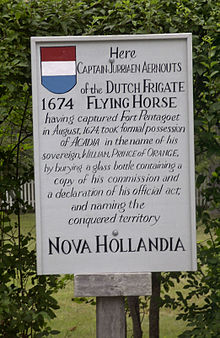Jurriaen Aernoutsz

Jurriaen Aernoutsz , also Aernoutson or Arentson , was a Dutch colonial ship captain who captured Fort Pentagouet in the French colony of Acadia in 1674 and took possession of the area for the Dutch crown.
Life
Apart from his brief involvement in academia, very little is known about Aernoutsz's life. During the Third Anglo-Dutch War he was captain of the frigate Flying Horse , which was stationed in Curaçao in the West Indies . After the Dutch were driven out of New Amsterdam , Aernoutsz had received an order from the Governor of Curaçao to attack English and French ships in the North Atlantic . On the way to New York in 1673 he received news of the Treaty of Westminster , in which England and the Netherlands had made peace. The war against France was not over, however. In New York Aernoutsz met John Rhoades , who knew the French colony of Acadia and offered himself to him as a guide. On August 10, 1674, the Flying Horse reached Fort Pentagouet on the Penobscot River , which was held by the Governor of Acadia, Jacques de Chambly, and about 30 men. The Dutch captured the fort within two hours. The wounded Chambly was captured and the fort destroyed. Aernoutsz then sailed east into the Bay of Fundy , plundered the French posts on the west coast and finally captured Fort Jemseg on the Saint John River .
Aernoutsz named the conquered area Nieuw Holland and took possession of it for the Dutch crown. His stay in Acadia lasted only a month and in September 1674 he drove back to Boston . Here he sold the booty from the looting, including the cannons from Fort Pentagouet, to the Massachusetts government . The captured French, as well as John Rhoades and some members of the Dutch company, stayed behind in Boston, while Aernoutsz made his way back to Curaçao in October 1674 to recruit Dutch settlers. In the meantime, John Rhoades and the Dutch who remained in Boston returned to Acadia to consolidate their tenure. They hijacked New England ships that wanted to trade with the Abenaki . Massachusetts viewed Rhoades and his people as pirates , all of whom were released from the colony and banished. The French were able to repossess the Acadia, while the Dutch government protested unsuccessfully in Whitehall . This had formally installed Cornelius Van Steenwyk as governor in 1676, but he never took office. The area remained under French control, although the Dutch maintained their tenure until the end of the war. In the Treaty of Nijmegen in 1678 they finally renounced academies.
Nothing is known about the further life of Jurriaen Aernoutsz.
Web links
- Jurriaen Aernoutsz . In: Dictionary of Canadian Biography . 24 volumes, 1966–2018. University of Toronto Press, Toronto ( English , French ).
literature
- George Francis Dow, John Henry: The Pirates of the New England Coast 1630-1730. Dover Pubn. Inc. 1996
Individual evidence
| personal data | |
|---|---|
| SURNAME | Aernoutsz, Jurriaen |
| ALTERNATIVE NAMES | Aernoutson, Jurriaen; Arentson, Jurriaen |
| BRIEF DESCRIPTION | Dutch ship captain, brief conqueror of Acadia |
| DATE OF BIRTH | 17th century |
| DATE OF DEATH | 17th century or 18th century |
